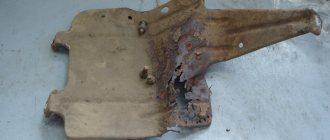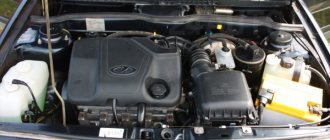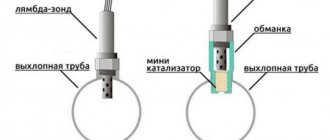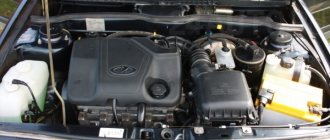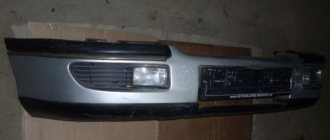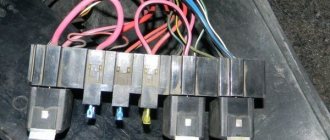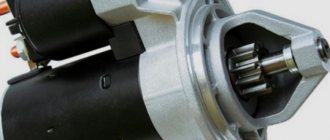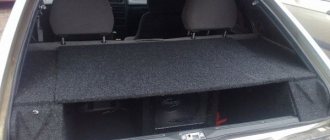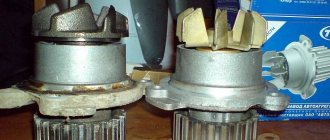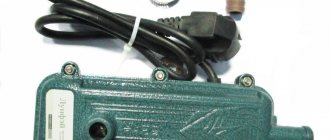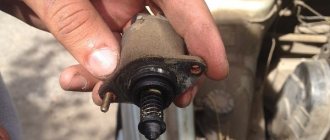Benefits of the 4-2-1 and 4-1 spider
Now many drivers install a 4-2-1 spider in their cars in order to increase their power. Although modern cars have reached great heights, car enthusiasts do not stop there and continue to improve their cars. Those who are familiar with tuning and also do not want drastic changes in the engine design can improve their car by installing a 4 2 1 spider. This spare part itself is an exhaust manifold, and in this article we will describe its pros and cons. But first, let's figure out what the difference is in exhaust manifolds and what types they come in.
Replacing the catalyst on a 16-valve VAZ 2114
On a VAZ 2114 with a 16-valve engine, the catalyst is structurally combined with the output manifold and is located in the engine compartment immediately behind the cylinder block. To replace it, a special insert is used, a zero-resistance catalyst, better known as a “spider”. Removing the catalyst and installing a spacer can also be done in a garage. To gain access, you will need to remove the fuel rail.
The peculiarity of removing the catalyst on 16-valve VAZ 2114 cars is that there are two lambdas. The first is installed on the catalyst itself and is responsible for setting the fuel mixture, and the second, “ecological”, is located on the flange after the catalyst. Its absence will inevitably cause a sensor error, a check engine indication, incorrect injection operation, increased fuel consumption and poor traction. There are two ways out of this situation.
- If you purchased a spider for one sensor, the ECU needs to be flashed from Euro-3 to Euro-2. In addition, the spider for one sensor has a drawback: the only thread for the lambda probe is located on the flange. To screw in the “injection” lambda, you need to assemble an extension cord from two male-female connectors and a wire.
- If there is a spider for two sensors, the “injection” lambda can be installed in its original place. The thread for the second sensor can be plugged or a “dummy” for the computer can be installed there. In the second case, flashing the ECU to Euro 2 will not be required.
Before removing the catalyst, you need to understand why it is needed. The power gain from this procedure is a myth. As well as the belief that an engine with a catalyst “does not breathe.” Removing a working cat (and if the odometer shows less than 100 thousand kilometers and diagnostics show the system is working, it works) will not add additional horses. However, the belief that driving with a clogged catalyst is more environmentally friendly than driving without it is also a fallacy.
Depending on the year of production of the VAZ 2114, they are equipped with catalysts that meet the requirements of Euro 2 or Euro 3 (2003-2008 and 2008-2013 model years, respectively).
Types of collectors
The first type is a standard exhaust manifold. It is installed on most modern cars for more environmentally friendly operation and combines the manifold and catalyst. Its main job is to burn the remaining unburnt gasoline.
The disadvantage of such a manifold is poor exhaust gas permeability; the four pipes that come out of the engine are too thin. In addition, after leaving the engine, the exhaust gases rest against the catalyst honeycomb, and pressure forms in the manifold, as if the catalyst is strangling the engine. But since the catalyst has a certain service life and the price is quite high, car owners are trying to replace it with a spider (how can you check the catalyst?). The ideal exhaust system would be if the exhaust gases went straight out onto the street without any exhaust pipes or manifolds, but driving such a car would be neither possible nor legal.
Pros and cons of the spider 4-1
The second type of exhaust manifold is the 4-1 spider. The structure of such manifolds is similar to a factory catalyst, but the 4-1 spider has four pipes that come out of the engine with a larger diameter and the exhaust gas retention is less pronounced. As a rule, this type of collectors is cheaper.
Its structure is simpler and it is a simpler form. The design of such a collector involves the connection of four pipes into one thicker one and then a transition to the resonator. They are most often used on sports, high-revving engines, since the operating range of the 4-1 manifold is over six thousand revolutions.
Pros and cons of the 4-2-1 spider
And finally, the latest manifold design used in civilian, atmospheric tuning is the 4-2-1 spider. The purpose of such a spider is to lengthen the collector itself as much as possible and make sure that the exhaust gases leaving the engine touch and interfere with each other as little as possible.
Replacement for an 8-valve engine
If you have a VAZ 2114 with an 8-valve engine, you need to look for this element in front of the middle resonator and after the exhaust manifold directly under the bottom of the car. Many, alas, ignore the need to replace it, believing that their car will not stop polluting the atmosphere and the engine will be able to continue to operate normally. The opinion is wrong, as you understand.
Device option for eight-valve
Some believe that instead of a failed filter device, you can install a regular corrugated pipe . Also a wrong decision. This will make the noise incredibly loud, and the exhaust gases will very quickly destroy the muffler. You can get by with a budget replacement option - cut out a section of the catalyst, knock out a honeycomb of ceramics from it and perform welding, thereby sealing the body. But be prepared for noise to become your constant companion.
It is best to replace the factory catalyst with an effective flame arrester. They assemble it with their own hands or seek help at a service station, and also purchase ready-made solutions at auto parts stores. Whichever option suits you best, choose that one.
Removing the unit and replacing it with another device is a matter of one hour. At the same time, there is no need to worry about electronics. There is only one oxygen sensor, and it is installed before the catalyst. Therefore, replacing it with a flame arrester will not affect the measurement readings in any way.
I installed the spider, do I need firmware?
Currently, there are a large number of manufacturers of sports spiders. They all claim that by installing a 4-1 spider or 4-2-1, the power of your four-cylinder engine will increase by up to 10%. This is confirmed by video clips and measurements on a dyno, but is it really so? Manufacturers don’t tell us a little, since replacing the standard manifold with a spider will disrupt the correct operation of the engine.
When a new car is produced, a standard program is installed in the engine control unit, which monitors exhaust gases and is set to a certain pressure in the exhaust manifold. When installing the spider, the pressure in the exhaust system changes and an engine error light appears on the dashboard. At the same time, the car begins to consume more gasoline and its power drops significantly. In order to avoid this, it is necessary to change the factory engine settings to the so-called euro two firmware, or even zero euro. Such firmware is more universal and can be easily installed at service stations where they do chip tuning. But absolutely identical motors simply do not exist, and in order to achieve maximum performance when installing a spider, you need to individually calibrate your engine.
I bought a spider 4-1 and want to install it instead of a catalyst, will it fit?
VAZ 21124 for sale
by Adminrive · Published 04/09/2017
When I brake the headlights become dim and when I lower the brake they become
by Adminrive · Published 02/27/2016
197 nah
by Adminrive · Published 02/12/2009
- Comments 27
- Pingbacks 0
This is not a 4-1 spider, but an insert to replace the 1.6 kata. of course it will do
Andrey, 1200-1500 in NN
Stepan, are you standing? Or is the cat in place?
Andrey, the horns of the catalytic collector flew off 1 and 4 first, then the lower flange
Stepan, I still have about 120k mileage
I have the same one.
Andrey, my horns flew off at 90, the lower one at about 120
Stepan, I understand) I won’t touch anything while it’s on the way, maybe it won’t fall off)
Andrey, the ox will start to fuck - feel free to change it to an insert, it’s not worth cooking - it won’t last long. and there's a lot of bullshit with removal
This is how they will always take it first and then whether it will fit or not.
I have the same
I bought it for 900 rubles, but should I take a gasket?
Andrey, they told me that my catalytic converter is almost finished, but I can still drive, and I read that due to a clogged catalytic converter, power is lost by 15-25%, and if I install this decoy, will the power increase?
Let's look at the pros and cons of removing the catalyst.
- Pros: fuel consumption decreases, the engine begins to “breathe” easier, it turns easier, the exhaust becomes freer.
- Cons: air pollution, inability to legally pass inspection, the need to change the firmware (if there are two oxygen sensors), the exhaust will become a little louder.
Many people ask the question: is it necessary to flash a car after removing the catalyst?
If your car has two oxygen sensors (Euro-3, Euro-4, etc.), then you will have to flash it; if there is only one (Euro-2), then it is not necessary.
And now a short report on replacing the catalyst with an insert on a Lada Kalina car with a VAZ 21114 1.6 l, 81 hp engine.
In order to get to the exhaust manifold, you must first disassemble the intake, because the intake/exhaust gasket is common on this engine.
To unscrew the hard-to-reach nuts located under the exhaust manifold, I came up with the following: I bought a spark plug type wrench, only 13, inserted a hex of the appropriate size on the back side, in my case it turned out to be a 12 hex.
Try to buy a high-quality tool; the edges of cheap wrenches quickly lick off and you won’t be able to unscrew anything with them.
Before starting work, be sure to lubricate all nuts with WD-40 penetrating lubricant.
After reading the forums of various sites, I still haven’t found a clear opinion on whether it is necessary to drain the antifreeze when removing the exhaust manifold or not. I decided not to risk it and drained the antifreeze from the cylinder block.
As is appropriate for such work, you first need to disconnect the terminals from the battery and remove it from the car, I also removed the air filter housing with the corrugation so that it does not interfere (this may not be necessary). Then I disconnected the injector power plug and disconnected the fuel rail, took it out and put it aside. I removed the throttle cable. In general, I removed everything unnecessary on the way to the catalyst.
Spider and its varieties
The main difference between the spider and the original VAZ exhaust manifold is:
- absence of sharp corners in the path of gases;
- multi-level direct-flow system (4-2-1 type);
- lack of internal components (it is they, first of all, that “bring” the engine’s performance to the Euro-3 standard and at the same time reduce its power).
In terms of its structure, the spider 4 2 1 2114 is a complex system of tubes connected to each other. As you might guess, there are 4 pipes coming from the engine itself, which at some distance combine into 2, and then into 1 exhaust pipe. This combination of tubes during engine operation creates air pressure differences, which contribute to maximum cleaning and purging of the cylinders and, as a result, increasing the overall engine power.
It should be noted that after installing the spider, the “environmental friendliness” of the car will decrease, and there will be no compliance with the Euro-3 standard. In all other respects, replacing this part will only benefit the car.
In addition to spiders of type 4 2 1, the action of which has already been described, you can also find spiders of type 4 1 in stores. The difference between them is that in the latter version, 4 tubes extending from the engine immediately turn into 1, bypassing the intermediate stage of 2 tubes.
Such spiders are intended exclusively for boosted engines and provide an increase in power compared to a standard manifold only at speeds of 6500 rpm or more. That is why the spider 4 2 1 on the VAZ 2114 is a better option than the spider type 4 1.
It should be noted that the entire modernization process will not be limited to just installing the spider. In addition to this, you will also need to install a direct-flow exhaust system, a resonator and remove the catalyst.
Thus, if you decide to replace the manifold, you will, in fact, have to replace the entire exhaust system. True, you can limit yourself to just replacing the catalyst with a resonator, but in this case the overall increase in power will be noticeably less (about 5 hp instead of 12-15 hp with a complete replacement of the exhaust system).
Breakdowns and their signs
Typically, this element begins to “strange” when it travels about 150 thousand kilometers. That is, this is more likely an age-related problem with the car.
Standard and Modified
The catalyst consists of honeycombs that break down over time and do not block the release of harmful exhaust gases. The pressure in the exhaust system increases, exhaust gases go back into the engine, which leads to a significant deterioration in its performance. The engine is literally choking.
Typical signs that the catalyst is clogged are:
- The car's dynamics deteriorate significantly and noticeably;
- The engine starts with problems;
- There is a characteristic smell of sulfur in the cabin;
- The engine is unstable at idle.
If the car stops driving normally, it is advisable to immediately check the condition of this device. Alas, this cannot always be done in a garage environment, since special equipment and devices are required. But there are still two ways.
- Replace the lambda probe with a pressure gauge. Start the engine and check the pressure. If it is more than 0.5 atmospheres, things are bad.
- In the second case, you will need a remote pyrometer. If the catalyst is working normally, the temperature of the pipe before it will be higher than after it. But at the same temperature, this indicates the destruction of the honeycomb and a violation of the flame extinguishing function.
The second method allows you to obtain indirect data, so the pressure must be checked in any case. If a breakdown is detected, the catalyst must be replaced.
Replacing the device has its own characteristics depending on which engine is installed on your VAZ 2114 - eight-valve or sixteen-valve.
How to make a replacement
The entire replacement of the VAZ 2114 spider takes place in several stages:
- Place the car on an overpass or pit, put the handbrake on and secure the wheels with stops (shoes).
- If the car has been running recently, let it cool down.
- Remove the crankcase protection.
- Unscrew the bolts securing the exhaust manifold pants to the catalyst inlet (to make unscrewing easier, they should be treated with WD-40 lubricant before starting work).
- If the replacement is partial, then leave the catalyst and muffler in place; if it is complete, then remove it.
- Unscrew the nuts securing the manifold to the cylinder head.
- Dismantle the “original” manifold and the gasket located under it.
- Install the spider instead of the standard manifold (if the spider matches the model, then it will definitely fit into its place). Before installation, you should place a new gasket under it.
- If the old fasteners are severely corroded, then new ones should be installed instead, preferably coated with copper or brass.
- If a partial replacement is performed, then you need to check the alignment of the spider pipe with the catalyst inlet. As a rule, the exhaust pipe of the spider is longer, so you will have to cut off and dismantle not only the catalyst, but also part of the exhaust pipe, instead of which a resonator should be welded.
- Connect the spider's output pipe to the resonator.
- If a complete replacement occurs, then the same operations are performed as in the previous paragraphs, but instead of the entire “original” exhaust system, a direct-flow exhaust system is installed.
After installing the spider, you will also have to replace the lambda probe (with a new one, with an extended wire). The completion of the entire modernization process will be the flashing of the ECU, which should be performed at a car service center. It will help register the new system in the computer as “standard”, and will also show the increase in power obtained as a result of the upgrade.
Some features
There are several nuances that should be taken into account when modifying the exhaust system of a VAZ-2114. The installed tuning manifold is wider in size, so it will touch the rubber pipe leading to the stove. To prevent this from leading to coolant leakage in the future, this pipe should be replaced with a new, longer one, and taken away from the manifold.
The lambda probe will also have to be replaced, since the hole for its mounting in the tuning manifold is lower than in the standard one, which is why this sensor with extended wiring is needed.
Also, the “Spider” is more voluminous at the bottom, so installing underbody protection is no longer possible.
The final stage of all this work is reflashing the electronic control unit, which will allow the new exhaust system to be “perceived” as standard. Also, flashing will allow you to “unleash” the full potential of the power plant after processing. It is better to perform flashing from knowledgeable specialists at a service station.
This is all the work related to the processing of the exhaust system of the VAZ-2114 car.
Video on replacing the catalyst on a VAZ 2114 spider:
In the context of the fight for the environment, car manufacturers are coming up with more and more sophisticated ways to reduce harmful emissions into the atmosphere, thereby preventing the engine from developing its full power.
The catalyst plays an important role in trapping harmful substances.
Installed in the exhaust system, it captures harmful substances from the exhaust, turning them into less harmful ones, acting as a kind of filter.
However, it is known that over time, every filter becomes clogged. With high mileage, the catalyst can cause deterioration in the vehicle's driving characteristics and increased fuel consumption. In addition, over time, the filter element, honeycomb, begins to crumble due to low-quality gasoline, thereby preventing the car from driving normally.
Since a new catalyst is expensive, many car enthusiasts resort to such a thing as removing the catalyst. Usually it is simply cut out or a so-called insert is installed instead.
